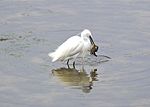Irun railway station

Irun is a railway station in Irun, Basque Country, Spain. The station is located on the Bordeaux - Irun, Bilbao - Hendaye and Madrid–Hendaye railway lines. The station is served by TGV (high speed trains) operated by the SNCF and Alvia (High Speed Trains), Talgo, Arco, Estrella and Cercanías San Sebastián services operated by RENFE. The station is a border railway station where all trains have to stop, as those coming from/going into France have to change gauge from 1,668 mm (5 ft 5+21⁄32 in) Iberian gauge to 1,435 mm (4 ft 8+1⁄2 in) standard gauge. The electric pickup supply also changes here from 3000 V DC (overhead Spain) to 1500 V DC (overhead France). Between the stations of Hendaye and Irun, both track gauges run together.
Excerpt from the Wikipedia article Irun railway station (License: CC BY-SA 3.0, Authors, Images).Irun railway station
Geltokiko kalea,
Geographical coordinates (GPS) Address External links Nearby Places Show on map
Geographical coordinates (GPS)
| Latitude | Longitude |
|---|---|
| N 43.339166666667 ° | E -1.8002777777778 ° |
Address
Irun
Geltokiko kalea
20301
Autonomous Community of the Basque Country, Spain
Open on Google Maps










